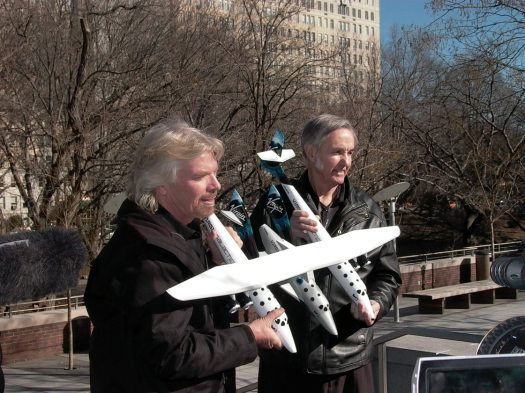Virgin Galactic unveils SpaceShipTwo; Plans open architecture spaceship

Virgin Galactic on Wednesday unveiled designs for SpaceShipTwo and the WhiteKnightTwo, two vehicles that are designed to usher in private spaceflight. The technology behind the system will have an open architecture "like Linux," said officials.
In an event at the American Museum at Natural History
Whitehorn clarified the open architecture point a bit: He said that if interested parties come to Virgin and Scaled Composites they can use key points such as WhiteKnightTwo's wing to build new aircraft. "We will work with people that come to work with us to do new things with the WhiteKnightTwo. If people come to us we'll work with them."
Whitehorn added that interested parties are already in discussions about building off of the properties of WhiteKnightTwo, but wasn't going to name names. Overall, Virgin Galactic wasn't detailing technical details behind the spaceship effort.
Branson noted that the system has the architecture that could be developed into a passenger carrying system, launch payloads and further science. Branson and Rutan argue that space flight and commerce will be as big as telecommunications, the Internet and information technology in terms of innovation and economic gains.
The event is ongoing, but I thought I'd get the images up. The big model is the launch system. The smaller one is SpaceShipTwo. As Whitehorn notes: "The thing is covered with windows."
SpaceShipTwo is 60 percent complete with test flights later this year. WhiteKnightTwo is 70 percent completed. Rutan said that WhiteKnightTwo will be the largest all carbon composite plane--he noted that Boeing's 787 is 50 percent carbon composite.
The event featured a bevy of customers and a few Virgin Galactic astronauts, who were running around in black Puma jumpsuits.
- Windows are 18 inches in diameter;
- Two systems move landing gear or tail so if one fails there's another system to pick up the slack;
- Designed to be flown twice a day;
- Roomy cabin with height roughly 7 feet;
- The configuration is designed to reenter the atmosphere at any angle. "This vehicle is designed to go into the atmosphere in the worst case straight in or upside down and it'll correct. This is designed to be at least as safe as the early airliners in the 1920s," said Rutan. Later in the press conference, Rutan was asked to clarify that 1920s comment. He said: "Don't believe anyone that tells you that the safety will be the same as a modern airliner, which has been around for 70 years." Rutan also noted that SpaceShipTwo will have to be 100 times more safe than government space travel.
- SpaceShipTwo and WhiteKnight are designed to be production vehicles. "If we can stay on schedule to build 40 or 50 they will reach 100,000s of people," said Rutan. "This is not a small program."
Virgin Galactic executives spent a lot of time talking about safety--how its astronauts of all ages could handle training, failsafe landings and other features. Why? Safety will be critical in luring the masses to take a spaceflight.